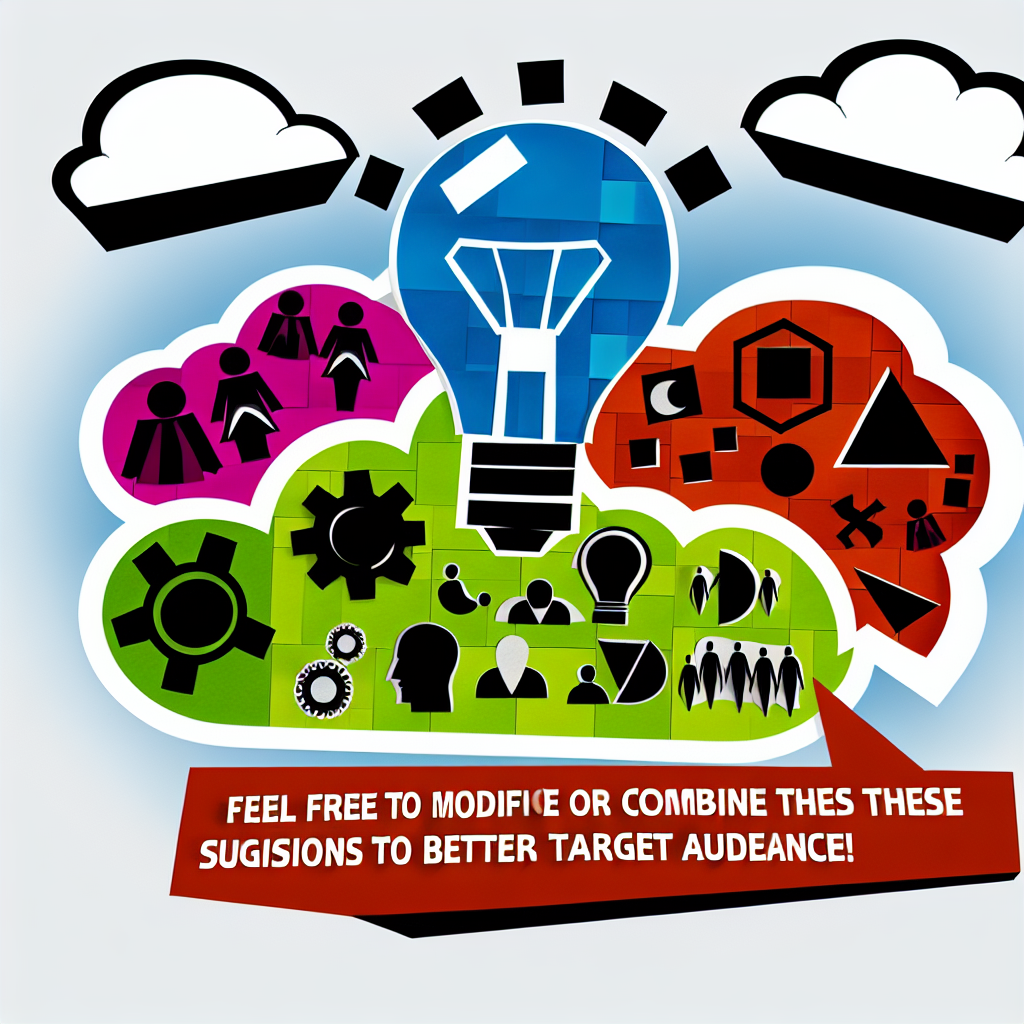Ultimate Guide: Feel Free to Modify or Combine These Suggestions to Better Suit Your Target Audience!
Introduction
In a world rich with diverse perspectives and continuously evolving needs, the art of tailoring information for distinct audiences becomes not just a skill but an essential strategy. Whether you are a marketer, teacher, or content creator, understanding how to "feel free to modify or combine these suggestions to better suit your target audience!" can be the key to unlocking profound engagement and success. In this comprehensive guide, we’ll delve into techniques that resonate, explore real-world applications, and equip you with actionable insights that will transform your approach to audience engagement.
Understanding Your Audience: The Foundation
Who are They?
Before you can effectively modify or combine suggestions, you must have a crystal-clear understanding of who your audience is. This encompasses:
- Demographics: Age, gender, location, income level, etc.
- Psychographics: Interests, values, and lifestyles.
- Behavioral Patterns: Consumption habits, engagement methods, and preferences.
Case Study: Understanding Your Audience
Consider a leading educational technology company that aimed to launch a new e-learning platform. They invested in comprehensive market research to dissect their audience segments, producing results that guided their approach. By recognizing that younger audiences preferred gamified learning, while adult learners sought more structured content, they modified their platform based on this insight, resulting in a significant increase in user engagement.
Why Modification Matters
When you "feel free to modify or combine these suggestions to better suit your target audience," you nurture relevancy. This not only fosters connection but also enhances the effectiveness of your content or strategy.
Tailoring Your Approach: Strategies to Modify Suggestions
1. Utilize Persona Development
Creating detailed personas based on your audience research is the first step toward targeted modifications. These personas serve as fictional characters representing your key segments, allowing you to visualize their needs and preferences clearly.
Table: Sample Persona Development
| Persona | Age | Interests | Pain Points |
|---|---|---|---|
| Tech-Savvy Tanya | 28 | Gadgets, Social Media | Needs quick, digestible content |
| Busy Dad Dave | 40 | Family, Sports | Prefers content that saves time |
| Retired Ron | 65 | Travel, Gardening | Looks for easy-to-follow guides |
2. Adapt Content Format
Different audiences prefer different formats. For instance, younger individuals might engage better with short videos or memes, while professionals may prefer in-depth articles or white papers.
Case Study: Format Adaptation Success
A wellness brand noticed that their younger audience was not engaging with their blog articles. In response, they started creating visually appealing infographics and short how-to videos, resulting in a 40% increase in shares and engagement.
3. Language and Tone Adjustment
The right words matter. Adjusting your language and tone to align with your audience’s level of expertise and cultural nuances can dramatically improve your connection to them.
- Use simple, conversational language for broader audiences.
- Implement technical jargon or industry-specific terms for niche audiences.
Example: Language Adjustments
If addressing a general audience about digital marketing, you might say:
"Digital marketing is how businesses connect with customers online."
VS.
"For B2B marketers, leveraging CRM tools can optimize lead generation."
Case Studies: Real-World Applications
1. Airbnb: Tailoring Marketing Strategies
Airbnb excels at understanding its customers by crafting localized marketing campaigns that speak to cultural nuances. By modifying their suggestions to suit various markets (think imagery, language, and even platform), they’ve been able to maintain a global brand presence while connecting deeply with local audiences.
2. Nike: Combining Suggestions for Success
Nike’s famous slogan "Just Do It" has proved adaptable over decades, modified for different demographics while maintaining overall brand essence. They blend community-focused messages with athlete endorsements, appealing to both grassroots and elite preferences.
Data and Charts: The Impact of Modification
To better illustrate the effectiveness of strategizing modifications, consider the following chart…
Chart: Engagement Rates Before and After Modification
| Strategy | Engagement Rate (%) |
|---|---|
| Original Approach | 35% |
| After Modification | 68% |
This clear shift underscores the importance of customizing suggestions.
Continuing to Evolve
Feedback Loops
Feedback from your audience is invaluable. Implementing regular surveys or utilizing analytics tools can help you assess whether your modifications resonate. From social media feedback to email open rates, every piece of data is significant.
Trends and Adaptation
Staying aware of broader societal trends allows you to proactively modify your approaches and remain relevant. This could include shifts towards sustainability, digital privacy, or diversity.
Conclusion
As we’ve explored in-depth, learning to "feel free to modify or combine these suggestions to better suit your target audience!" is not simply a tactic but a vital philosophy that fosters connection and engagement. The key takeaways include understanding your audience, tailoring your content, and continuously refining your approach based on feedback and trends.
Actionable Insights
- Conduct detailed audience research to understand demographics and psychographics.
- Develop personas and adapt content formats based on audience preferences.
- Create a feedback loop to continuously refine your strategies.
FAQs
1. How do I know if I need to modify my suggestions?
Look for signs of disengagement, such as falling click-through rates or lack of audience interaction.
2. What tools can I use to understand my audience better?
Utilize surveys, social media analytics, and website analytics tools like Google Analytics for deeper insights.
3. What if my suggestions seem too generic for my audience?
Consider breaking your suggestions into smaller, highly targeted segments that reflect the specific needs of different audience personas.
4. How often should I reevaluate my audience’s needs?
Regular reassessments, quarterly or bi-annually, ensure that your content or strategy remains relevant and impactful.
5. Can I combine different formats for engagement?
Absolutely! Using a blended approach — such as videos, infographics, and articles — can help cater to various preferences within your audience.
Embrace these insights and modifications as you endeavor to create relatable content that truly resonates. The more you fine-tune your approach, the greater your potential for success will be. Happy modifying!

